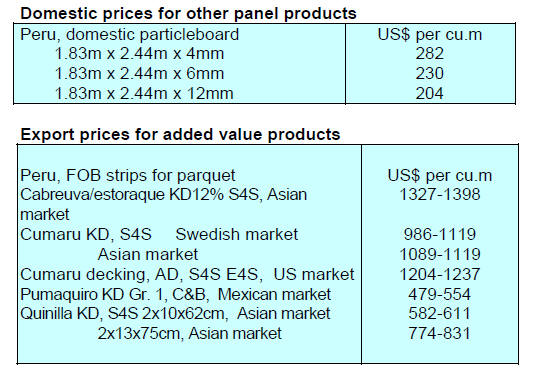4.
INDONESIA
Promotion to capture larger share of
German Market
Indonesia plans to initiate joint promotion with a number
of stakeholders as part of an effort to expand the market
share of Indonesian wood products in Germany. This was
announced by Arif Havas Oegroseno, Indonesia’
ambassador in Germany, when opening a dialogue
between Indonesian-German wood product business
players facilitated by the Embassy, “It is very important to
carry out a joint campaign to stimulate the German market
for Indonesian FLEGT-licensed products.”
Ambassador Havas also explained the cooperation
programme between Indonesia and the University of
Freiburg to study the market for industrial wood products
in Europe and how Indonesian products can help satisfy
the market demand.
Data from Indonesia’s Ministry of Environment and
Forestry shows that in 2021 the value of Indonesian wood
product exports to Germany reached US$171.1 million, an
increase of 23% from 2020. The main product exported
was furniture generating US$73.9 million in earnings
followed by wood panels (US$37.9 million).
Nils Olaf Petersen, Head of the Foreign Trade Department
at GD Holz, (German Wood Trade Assoc.) explained his
Association would support activities to promote
Indonesian wood products saying “The market is very
good and there is an increasing demand for wood products
in Germany”. Petersen also explained that the market
opportunities are widening with the cessation of timber
imports from Belarus and Russia due to the invasion of
Ulraine.
See:
https://forestinsights.id/2022/03/10/promosi-bersamaproduk-kayu-indonesia-untuk-rebut-pasar-jerman/
Opportunities in Europe, but furniture makers focus on
America
Although there are opportunities for greater furniture
exports to Europe most furniture makers in the country
focus on the US market where demand is predicted to
continue growing significantly until 2024 as US importers
reduce purchases from China.
Chairman of the Indonesian Furniture and Craft Industry
Association (HIMKI), Abdul Sobur, said there is a market
opportunity of up to US$24 billion left by China in the US
and that Indonesia still has the capacity for furniture
export growth, especially to the US, over the next three
years. HIMKI projects that furniture exports in 2024 could
reach US$5 billion.
Over the past year the value of furniture and craft exports
reached US$3.42 billion, up 26% year-on-year. As for this
year, the export value is targeted at US$3.69 billion.
See:
https://ekonomi.bisnis.com/read/20220316/257/1511494/adapeluang-di-eropa-pengusaha-furnitur-enggan-bergeser-dariamerika.
Carbon pricing promises business opportunities
According to the Executive Director of the Belantara
Foundation, Dolly Priatna, the carbon pricing scheme
developed by Indonesia can support achievement of the
country’s commitment to reduce greenhouse gas (GHG)
emissions and will be a business opportunity for Forest
Utilization Licensing Companies (PBPH) and
communities that manage forests.
See:
https://forestinsights.id/2022/03/18/indonesias-carbonpricing-scheme-promises-business-opportunities/
Minister urges shipping companies to open direct
international routes
The Minister of Transportation, Budi Karya Sumadi, has
urged ships owners and shipping companies to open direct
international routes to improve Indonesia's logistics
competitiveness. He made the request while attending the
inaugural launch of the shipping company PT Meratus
Indonesia-China shipping route in collaboration with the
operator of the Container Terminal of Tanjung Priok Port.
See:
https://en.antaranews.com/news/219941/minister-urgesshipping-companies-to-open-direct-international-routes
Forestry sector to contribute to reduction in carbon
emissions
The government, through the Ministry of Environment and
Forestry, has determined that the forestry sector and other
land use sectors could contribute to reducing carbon
emissions by 60% by 2030. The government has prepared
an operational plan to increase carbon absorption by the
forestry and other land use sectors as described in a
Decree of the Minister of Environment and Forestry
Number 168 of 2022.
In a press statement the Minister of Environment and
Forestry, Siti Nurbaya, indicated that with this legal basis
Indonesia will continue to meet climate control targets
especially reducing deforestation and forest degradation.
See:
https://en.antaranews.com/news/219893/forestry-sector-tocontribute-to-60
BMKG forecasts higher potential of forest, land fires in
2022
The Indonesian Meteorology, Climatology and
Geophysics Agency (BMKG) has warned of the potential
for forest and land fires to be greater in 2022. Acting
Deputy of Climatology at BMKG, Urip Haryoko, noted
that this year the dry season is expected to normal
compared to last year when there was unexpected rain
during the dry season. During a press conference Haryoko
commented that several hotspots were currently being
monitored such as in Aceh, Riau, South Sumatra, North
Sumatra, Bangka Belitung Islands and West Kalimantan.
See:
https://en.antaranews.com/news/220713/bmkg-forecastshigher-potential-of-forest-land-fires-in-2022
Indonesia has shown tremendous effort to reduce
deforestation - FAO
FAO Indonesia noted in a statement to welcome the
International Day of Forests that, despite all the priceless
ecological, economic, social and health benefits forests
provide, global deforestation continues at an alarming rate.
The world is losing 10 million hectares of forest a year –
more than half the size of Sulawesi – and land degradation
affects almost 2 billion hectares, an area larger than South
America.
Forest loss and degradation emit enormous quantities of
climate-warming gases and it is estimated that more than
eight percent of forest plants and five percent of forest
animals and birds are at “extremely considerable risk” of
extinction.
The statement says “the government of Indonesia has
shown tremendous effort to reduce deforestation. We need
to appreciate this effort by supporting the Indonesian
government to enforce the law to protect the forest and the
forest community as the fundamental aspects in managing
sustainable forest”.
Indonesia’s G-20 presidency also boosts Indonesia's
programme to achieve sustainable economic development
and the year 2045 targets to include sustainable
management of forests.
See:
https://www.fao.org/indonesia/news/detailevents/ru/c/1479558/

5.
MYANMAR
ASEAN Envoy -
little hope of breakthrough
Cambodian Foreign Minister Prak Sokhonn, the ASEAN
envoy, has met with Myanmar’s military rulers. Prak
Sokhonn’s trip comes amid frustration in ASEAN over
Min Aung Hlaing’s failure to honour the five-point
ASEAN “consensus” to end hostilities and start a peace
process that he agreed to last year at a summit in Jakarta.
Sokhonn said there is no sign of negotiations aimed at
achieving reconciliation and that many factions in the
conflict are not ready to talk”.
Speaking to the domestic press in Myanmar the envoy said
the Myanmar issue was complicated and would take a long
time to solve as the “stakeholders were not ready to
cooperate and still insist on fighting and eliminating one
another.”
Sokhonn became ASEAN’s special envoy for Myanmar
after Cambodia took the rotating ASEAN chair this year.
His appointment came after Cambodian Prime Minister
Hun Sen visited Myanmar to meet the coup leader in
January. That visit has been criticised for seeming to
legitimising the regime.
During discussions Myanmar made clear that the Five-
Point Consensus (proposed by ASEAN and supported by
USA, EU and Japan) must be led by Myanmar. Wunna
Maung Lwin, Foreign Minster said that the
implementation of the Five-Point Consensus must be a
‘Myanmar-owned’ and ‘Myanmar-led’ process. A press
statement from Myanmar’s Foreign Ministry said that the
special envoy’s first visit to Myanmar would pave the way
for confidence building and understanding to promote
cooperation in ASEAN.
See:
https://www.irrawaddy.com/news/burma/asean-envoy-seeslittle-hope-of-breakthrough-in-myanmar.html
GDP Growth 3.7% Expectation of Myanmar SAC
Myanmar’s State Administration Council (SAC) has
predicted 3.7% GDP growth in the next fiscal year
whereas the World Bank has predicted just 1%. The leader
of the SAC, Senior General Min Aung Hlaing, was also
quoted as saying that SAC would try to achieve the
objectives of the 5-Year National Plan which begins soon.
This news attracted a variety of views from the critics
inside and outside the country. The factors which will
influence growth prospects are first, the power supply
which is seriously disrupting manufacturing, the second
are external factors. Investment in the country is in decline
and the sanctions imposed are biting. The third factor
likely to undermine growth prospects is the nonfunctioning
banking system.
see -
https://thediplomat.com/2019/04/erin-murphy-on-the-stateof-myanmars-economy/
)
Thai firm takes over after Chevron, Total pull out
Thai energy company PTTEP has said it will take over the
running of Myanmar’s vital Yadana gas field following
the withdrawal of Chevron and Total Energies. PTTEP, a
unit of Thailand’s majority state-owned energy firm PTT,
will take control of operations from July.
The Yadana gas field in the Andaman Sea provides
electricity to Myanmar and Thailand, one of a number of
gas projects that Human Rights Watch says make up the
government’s largest source of foreign currency earnings
of around US$1 billion annually. The gas concession
accounts for roughly 50% of Myanmar’s gas demand and
around 11% of Thailand’s consumption.
See:
https://www.irrawaddy.com/news/burma/thai-firm-takesover-myanmar-gas-field-after-withdrawal-of-chevron-total.html
)
6. INDIA
Wholesale price
indices for February 2022
The Office of the Economic Adviser, Department for
Promotion of Industry and Internal Trade has published
wholesale price indices for February 2022.
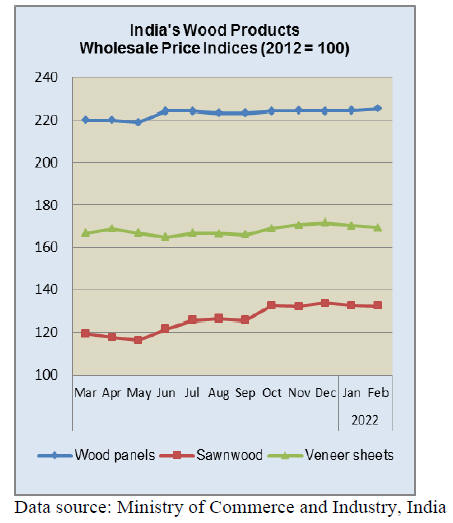
The index for manufactured products rose to 138.4 in
February from 137.1 for January. Out of the 22 groups of
manufactured products in the index for 18 increased there
were price increases while 3 saw a drop in prices. The
increase in prices was for basic metals, textiles, paper and
paper products, chemical and chemical products.
The overall index for manufactured wood and wood
products has drooped from a high of 5.76% in October
2021 to 4.55% as of February 2022.
The annual rate of inflation was 13.1% in February 2022
compared to 4.83% in February 2021.
The high rate of inflation in February 2022 was primarily
due to rise in prices of mineral oils, basic metals,
chemicals and chemical products, crude petroleum and
natural gas, food articles and some non-food articles such
as plywood where the index titled slightly higher in
February.
See:
https://eaindustry.nic.in/pdf_files/cmonthly.pdf
Log exports from Sabah welcomed
India importers of hardwood logs have welcomed the
decision of the Sabah State Government to resume log
exports. Currently, India import logs mainly from
Sarawak.
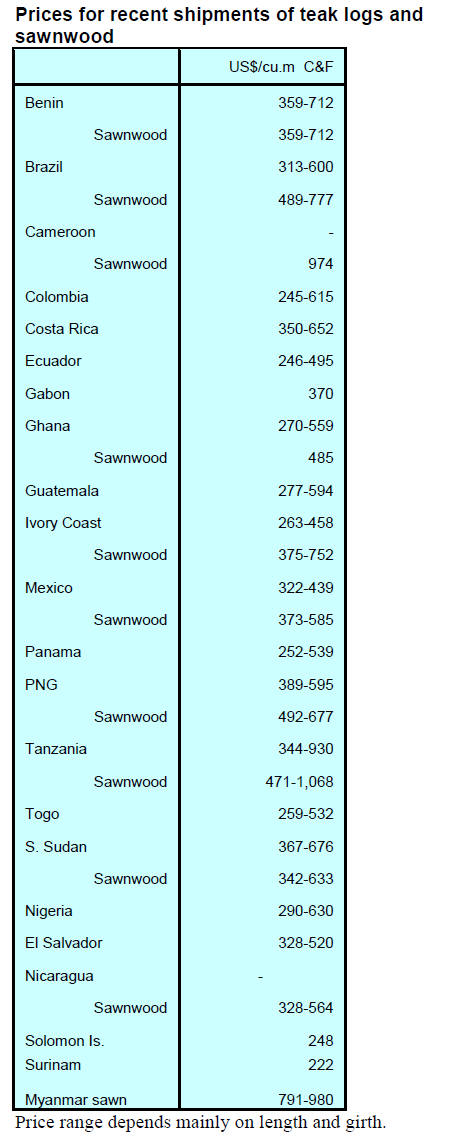
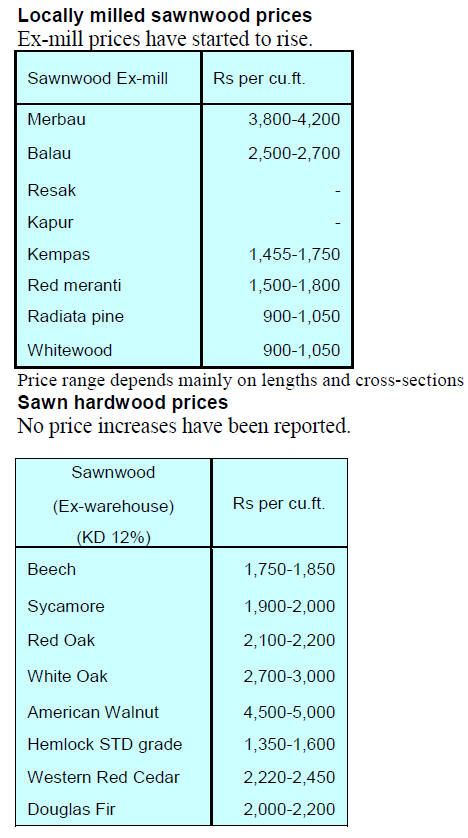
Shortage of domestic peeler logs
During a webinar organised by Plyreporter on 'Shortage of
Wood in North India', experts have clearly indicated that
by 2025, there will be a severe shortage of peeler logs in
North India.
It was pointed out that this situation presents a big
challenge for the industries located in Haryana, Punjab and
Uttar Pradesh. It is clear that due to the imbalance in
supply and demand of wood in North India, prices will
increase further and plywood prices are likely to increase
by at least 10-12% in the next few quarters.
See:
https://www.plyreporter.com/magazine-February-2022
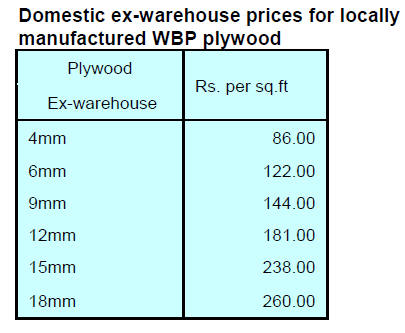
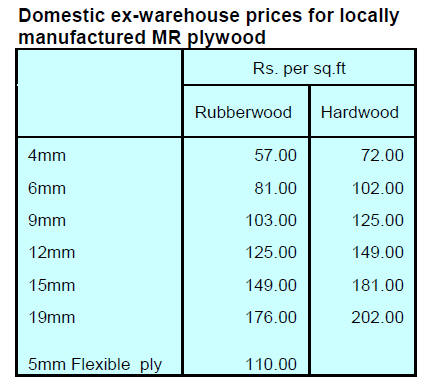
7.
VIETNAM
High costs hit wood product manufacturers
The local media outlet, ‘Vietnamnews’ has reported that
rising input costs are eroding the profits of wood product
manufacturers putting them at risk. Additionally, sanctions
on Russia are likely to cause a decline in supplies of
timber raw materials from Russia. As timber supplies
become tighter, Vietnamese firms will have to compete
more fiercely in international markets especially for
timbers from the EU and the US.
According to VIFOREST Vietnam has been importing 5.5
– 6.5 million cubic metres of timber raw material every
year. Higher raw material prices coupled with mounting
transportation costs have added to import bills driving
down profitability.
Vietnamnews quotes Phan Văn Phước, director of Tân
Phước Co. Ltd., forecasting that the timber shortage
will last for some months. He said his firm had to raise
prices to remain operational and would not import
additional timber in the short term due to high costs.
Tran Quoc Manh, general director of Sai Gon Trading
Production Development JSC is more concerned about
fuel costs than timber prices. He said petrol prices had hit
up to VND27,000 (US$1.18) per litre exceeding
manufacturers’ capacity to absorb the rise. Accordingly,
manufacturers are reluctant to sign new contracts for fear
that petrol prices will continue to go up further.
“Many manufacturers of wood products have to stay idle
amid high fuel costs and freight rates. They are unwilling
to sign new contracts due to cost uncertainties,” he
explained.
Rising oil prices have pushed up freight rates bringing
transportation costs to a new high. Freight rates have
increased fivefold since the pandemic began and the
Russian invasion of Ukraine has made things worse.
The Chairman of Dong Nai Province’s Association
of Wood and Handicraft, Le Xuan Quan, has urged the
authorities to discuss with shipping lines how to stabilise
freight rates. He also called for close cooperation between
forest growers and timber-processing firms to develop
sustainable sources of timber for the industry to lower the
dependence on imported materials.
A spokesperson for General Import and Export Van Xuan
Corp. has suggested a data portal on timber to help
manufacturers monitor prices and supply to better manage
input costs and inventories.
See:
https://vietnamnews.vn/economy/1163524/highinput-costs-hit-wood-product-manufacturers.html
Imports from Russia fall
At a recent event hosted by VIFOREST to exchange
information on the possible impacts of Russia’s invasion
of Ukraine furniture manufactures discussed the search for
timbers to substitute for Russian birch. Locally produced
acacia and rubberwood higher quality were identified as
possible alternatives.
Vietnam's imports of wood raw materials from Russia in
2021 accounted for 130,220 cu.m or about 2% of total
wood raw imports. In January 2022 the volume of imports
of wood from Russia continued to drop to just 8,560 cu.m.
Over 90% of the timber imports from Russia in 2021 was
sawnwood with the balance being plywood, veneer and
other wood-based panels.
The top species Vietnam imports from Russia is birch
followed by pine, spruce and fir. In 2021, birch
sawnwoodr imported from Russia into Vietnam accounted
for 81% of the total sawnwood imports.
Wood and wood product trade highlights
According to statistics from the General Department of
Custom, Vietnam's wood and wood product (W&WP)
exports to South Korea in February 2022 reached
US$48,400, up 1% compared to February 2021.
Vietnam's office furniture exports in February 2022
reached US$20 million, down 26% compared to February
2021. In the first 2 months of 2022 exports of office
furniture were worth US$55 million, down 26% compared
to the same period in 2021.As wood product export
growth was positive in the first two months of 2022 many
firms are increasing capacity to meet current orders until
the end of the second.
Products from Vietnam are very competitive and exporters
benefit from the various free trade agreements signed.
Trade will get a boost as international arrivals are now
possible.
Vietnam's pine imports in February 2022 reached 50,300
cu.m, worth US$14.6 million, down 4% in volume and
4% in value compared to January 2022. Compared to
February 2021 they were down 57% in volume and 42%
in value.
US$20 billion in wood product exports in 2025
Vietnam is targeting US$20 billion in wood product
exports in 2025, an increase of more than US$9 billion
compared to the present. The goal is to develop a
sustainable and efficient wood processing industry
for 2021-2030 said the Deputy Prime Minister Lê Văn
Thành.
The total export value of wood and forest products is
targeted at US$25 billion by 2030. The value of wood
products for domestic consumption will reach US$5
billion in 2025 and over US$6 billion in 2030.
By 2030 the domestic wood processing industry
will become an important economic sector and will have
built a good reputation in domestic and export markets. To
achieve this it will be necessary to further develop
infrastructure and expand the scale of production. There
are plans for five forestry zones with high technology
applications to attract investment from wood processing
enterprises. The country will build an international
furniture exhibition centre and encourage research and
design centres.
Expanding forest cover
Thirty year ago due to over-exploitation and the war only
27% of the country was covered by forests however, by
2021 that had risen to 42% and the goal is to reach 45% by
2030.
The Ministry of Natural Resources and Environment has
called for the increasing application of science and
technology in the reforestation and the association of
forests with environmental services, ecotourism and
biodiversity conservation. The national reforestation
program includes the creation of a digital map of trees
aimed at improving the conservation efforts and the
forestry industry.
See:
https://www.plenglish.com/news/2022/03/21/vietnamreaffirms-will-to-expand-forest-coverage/
In related news, Deputy Prime Minister, Le van Thanh,
has approved a 10-year project to improve forest rangers’
capacity in management, protection and firefighting. The
project aims to reduce at least 10 to 15% of law violations
in the forestry sector compared to the 2015-20 period,
especially deforestation, illegal harvesting
and transportation and forest burning.
To realise the targets, personnel training is key. At least
50% of forest protection and firefighting forces must be
trained with professional skills and be equipped with
forest protection devices.
8. BRAZIL
Demand for timber from natural
forests increased
during pandemic
According to the Union of Wood Industries in the North of
Mato Grosso (Sindusmad), in 2020 the timber industry in
the region earned R$368 million due to firm demand and
rising prices. Since 2020 prices for some species doubled,
for example the price of cambará (Moquiniastrum
polymorphum) jumped from R$1,000 to R$2,000 per
cu.m. The pace of price increase was also driven by
demand in the construction sector which caused a rise in
construction materials which had a knock-on impact on
wood prices.
Brazilian system to help wood identification
The “Interactive Wood Identification Key” system created
by the Brazilian Forest Service forest products laboratory
(LPF/SFB) is a tool for species identification. The system
utilises an on-line database with details of 275 tropical
timber species ranging from the most commercialised to
some endangered species. Recently, several species that
share a common name were added. For instance the
number of species that are known commercially as ipê
(Handroanthus) has increased.
The LPF system contributes to combating the illegal
timber trade as timber identification is key to allowing
enforcement agents to curb environmental crimes. In 2021,
the system enabled employees working in the
environmental inspection division of the Federal Highway
Police (Polícia Rodoviária Federal - PRF) in the state of
Maranhão to identify 6,214 cu.m of suspect wood, some
50% more than what was seized the previous year. The
Federal Police are partnerin the “Interactive Timber
Identification Key” system for technical support.
The BioAmazônia Project and the Amazon Cooperation
Treaty Organization also collaborate to develop the
system.
Export update
In February 2022 Brazil’s exports of wood-based products
(except pulp and paper) increased 45% in value compared
to February 2021, from US$284.8 million to US$413.9
million.
Pine sawnwood exports grew significantly (49%) in value
between February 2021 (US$46.2 million) and February
2022 (US$68.9 million). In volume terms exports
increased around 7% over the same period, from 238.500
cu.m to 254.300 cu.m.
Tropical sawnwood exports in February increased slightly
(2%) in volume, from 30,100 cu.m in February 2021 to
31,800 cu.m in February 2022. In value, exports decreased
1.6% from US$12.6 million to US$12.4 million, over the
same period.
In February pine plywood exports experienced a 37%
increase in value compared to February 2021, from
US$66.3 million to US$90.5 million.
In volume terms pine plywood exports increased 18% over
the same period, from 194.500 cu.m to 229.700 cu.m.
As for tropical plywood, exports increased in volume
(13.5%) and in value (26%), from 5.200 cu.m (US$2.3
million) in February 2021 to 5.900 cu.m (US$2.9 million)
in February 2022.
Wooden furniture exports increased from US$55.1 million
in February 2021 to US$60.3 million in February 2022, an
almost 10% growth.
Online system to raise efficiency of timber exports
The Brazilian National Confederation of Industry (CNI)
has launched a Single Consent Platform for Brazil (Pau-
Brazil) developed by the Brazilian Institute for the
Environment and Renewable Natural Resources
(IBAMA).
This initiative was developed over three years and
provides for the registration of Brazilian biodiversitybased
products from the natural forest. The expectation is
that the digitisation of the procedure will provide
advantages in terms of processing time and costs as
paperwork is eliminated.
The system integrates IBAMA's CITES information with
the SINAFLOR (National System for the Control of
Origin of Forest Product) licenses process to create onestop
portal. Around 35,000 wood and non-wood products
from natural forests are exported throughout Brazil every
year. Most of these products are exported from the four
main ports in Pará, Paraná, Santa Catarina and Amazonas
through which more than 90% of the exported
biodiversity-based pass.
Brazilian furniture at Expo Dubai
The Brazilian furniture sector is participating in Expo
Dubai which began in February. The event attracts
professionals, companies and buyers from all over the
world related to the furniture industry.
27 Brazilian brands associated with the Brazilian Furniture
Sector Project have participated in Dubai Trade Mission
organized by the Brazilian Furniture Industry Association
(ABIMÓVEL) and the Brazilian Trade and Investment
Promotion Agency (Apex Brazil).
To promote business networking round-tables will be held
through a matchmaking process between Brazilian brands
and around 35 international buyers from the UAE and
other Middle Eastern countries.
The Middle East is one of the most relevant target markets
for the Brazilian furniture industry. Exports to Saudi
Arabia, the main destination for Brazilian furniture in the
Middle East, increased by 290% last year. The UAE, the
second largest destination, registered an over 80% increase
in furniture imports from Brazil in 2021.
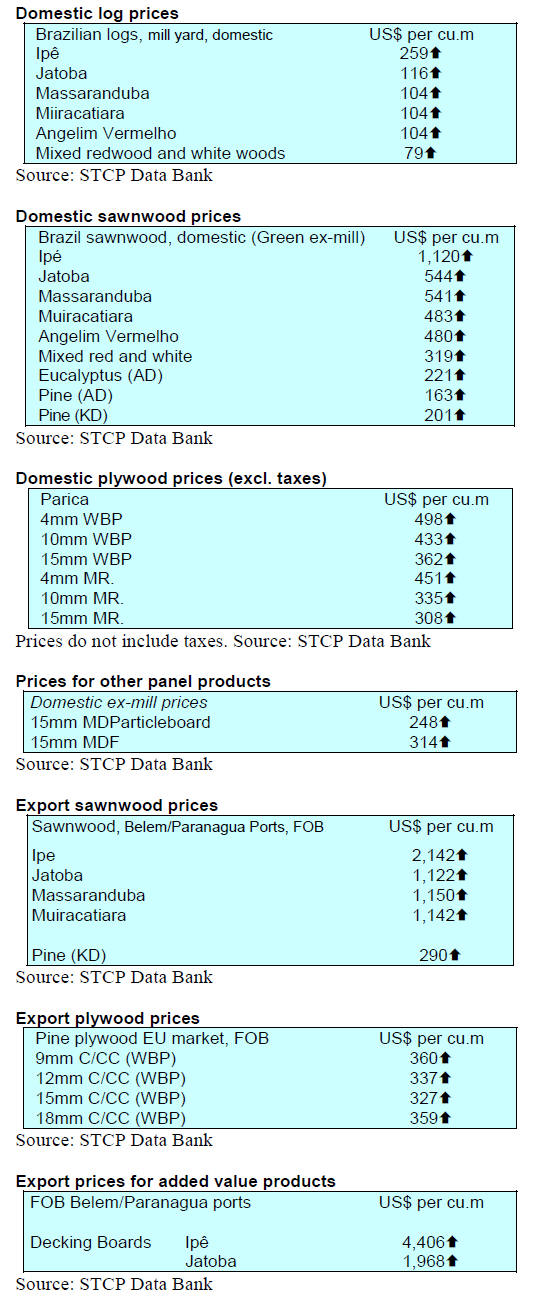
9. PERU
Sawnwood shipments rising
ADEX, the Association of Exporters, has reported the
value of sawnwood exported in January this year was
US$2.5 million, up 9% compared to the same month in
2021. There was strong demand in Mexico and the
Dominican Republic.
However, the January 2022 value was below that in 2020
(US$3.4 million) due to the high level of Chinese imports
(US$1.5 million) that accounted for 46 % of the total. In
January of this year the main export destination was
Mexico (US$0.7 million) a growth of 127% year on year,
the Dominican Republic (US$0.65 million), an increase of
91%.
Sawnwood was also shipped to Vietnam (US$0.55
million), China (US$0.23 million), Ecuador (US$0.12
million), the US (US$0.10 million) and smaller amounts to
Germany, Belgium and Spain. These last three
destinations are recent additions. With 26% of all wood
products sold abroad, sawn wood ranked second after
semi-manufactured products (US $5.9 million).
In addition, construction products were shipped (US$0.31
million); other manufactured products (US$0.29 million);
furniture and parts (US$0.18 million and plywood
(US$0.16 million).
According to figures from the ADEX Data Trade
Commercial Intelligence System, in 2021 (January-
December) shipments of sawn wood reached US$33.6
million, an increase of 35% compared to 2020 (US$24.9
million) and the highest in five years.
The largest buyer was China (US$10.7 million) with a
32% share and an increase of 5.4% year on year followed
by the Dominican Republic (US$8.7 million, up 75%,
Vietnam (US$4.8 million up 67%), Mexico (US$3.1
million, down 17% and Ecuador (US$2.4 million, up 89%.
Last year six new markets were added; Singapore,
Belgium, Martinique, Finland, New Caledonia and Puerto
Rico.
IMF – country faces uncertain economic outlook
A recent IMF report says Peru faces an uncertain outlook
after its strong recovery. The strong policy response in
2020 mitigated the worst impact of the pandemic and
created conditions for a rapid recovery. Firm international
demand, higher commodity prices and pent-up domestic
demand contributed to real GDP rising by 13.3% in 2021,
exceeding its pre-pandemic level in the third quarter of
2021. In addition formal employment fully recovered.
However, Peru is still suffering high social and economic
costs from the pandemic. Many lives were lost as Peru had
one of the highest death rates globally.
Real GDP remains below its pre-pandemic level and
labour force participation and employment has not fully
recovered and poverty increased in 2020 and is still above
pre-pandemic levels despite some improvement in 2021,
says the IMF. Overall says the IMF “the outlook is very
uncertain and downside risks prevail. Growth is expected
to slow to 3 percent in 2022 as external conditions tighten
and the policy stimulus is withdrawn”.
See:
https://www.imf.org/en/News/Articles/2022/03/07/mcs030722-peru-staff-concluding-statement-of-the-2022-article-iv-mission
National Forestry Fair - FENAFOR
Entrepreneurs and professionals in the forestry sector will
have the chance to visit the National Forestry Fair –
FENAFOR scheduled for 10-12 November 2022. This fair
features technology, raw material suppliers, accessories
and services for the forestry industry. The Fair will be held
in an exhibition centre in Lima.

